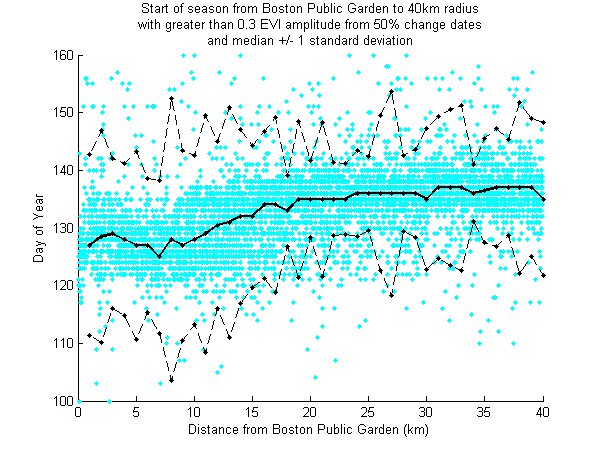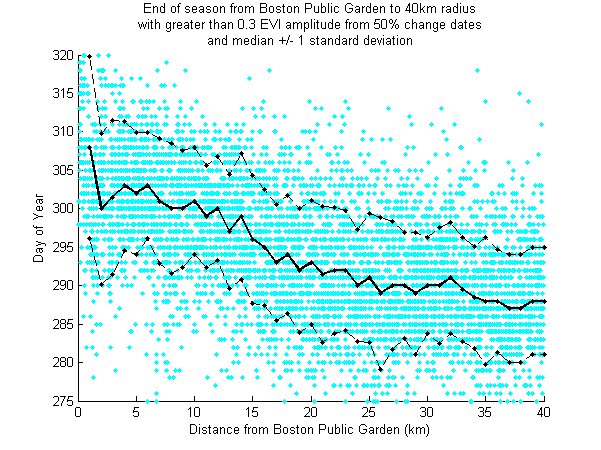You are here
Boston's a pretty hot town, or at least the trees think so
Once again, I find myself wondering why this slope is so steep. The curve shows the approximate date that autumn begins relative to distance from downtown Boston, and the results are mind-boggling. I look over to my research partner, Memo Terrazas, from the University of Texas at Austin. "Fall starts half a day later per kilometer into the city... that can't be right." This is incredible. It appears that parts of Boston have an extra whole month of summer compared to relatively "rural" areas, like Framingham, less than 40 km from the Boston Public Garden.
Climate change is more local than you might think. Although there are massive implications across the entire planet, it can be seen within relatively small areas due to human activities. One effect is that places with high levels of human development, likes cities, tend to be warmer than nearby rural or less-developed areas. This is called an urban heat island, and it exists because of asphalt, pavement, concrete, etc. These surfaces are the skin of our urban areas, and they are exceptionally good at absorbing solar radiation. When they re-emit the energy at longer wavelengths during nighttime hours, the air temperature can be artificially increased, far beyond what it would be in a natural setting.
![[The red part indicates that it's warmer closer to Boston.]](/sites/default/files/REU_Miller2_2013.jpg) One way to study climate is through the seasonal cycles of plants and animals, a research field known as phenology. Phenology encapsulates the timing of events in biological processes because of temperature, sunlight, etc., and we are looking at how deciduous vegetation can be used to evaluate the urban heat island of Boston. Deciduous plants, like oaks and maples, follow an expected seasonal trend: they lose their leaves in autumn, and regain them with alacrity in spring. We can define the change of seasons by these phenological events, and the specific dates that spring and autumn begin can vary widely from location to location.
One way to study climate is through the seasonal cycles of plants and animals, a research field known as phenology. Phenology encapsulates the timing of events in biological processes because of temperature, sunlight, etc., and we are looking at how deciduous vegetation can be used to evaluate the urban heat island of Boston. Deciduous plants, like oaks and maples, follow an expected seasonal trend: they lose their leaves in autumn, and regain them with alacrity in spring. We can define the change of seasons by these phenological events, and the specific dates that spring and autumn begin can vary widely from location to location.
In order to find this diversity in seasonality, we have turned to using satellite data in order to see broad trends across the landscape. We are using two satellite sensor systems, MODIS (Memo) and Landsat (myself), both launched by NASA. These are essentially big cameras that are able to distinguish between different wavelengths of light. The MODIS sensor is housed on two different satellites, Terra and Aqua, and although it is able to obtain data on a near-daily basis, it has to forgo spatial resolution as a consequence, dividing the data into blocks, or pixels, that are about 500 m on a side. Landsat on the other hand, while it only circles around to the same location on the planet every 16 days, has pixels that are 30 m on a side. As a result, Landsat is much better for finding subtle variations in surface features. This is the key reasoning behind my mentor's (Eli Melaas) approach. There are few trees in the concrete jungle, and so performing the high-wire act of finding purely deciduous pixels in downtown Boston, for example, can be notoriously tricky to do right.
But we can find these pixels by looking to the enhanced vegetation index, or EVI, which essentially determines how "vegetative" an area is based on the reflective properties of plants. A high EVI corresponds to dense vegetation, and vice versa. By combining image data, we have found the EVI for every pixel in every usable image that contains Boston. Then we can plot them by day of year, and with a best-fit curve can find the average dates of spring and autumn for every deciduous pixel in the scene. Only pixels that have a strong enough change in EVI throughout the year, going from bare in winter to fully leafed-out in summer, can we call deciduous. With these average dates in mind, we can visualize the urban heat island as it impacts deciduous plants.
Our current process is based on distance from the Boston Public Garden, but we will soon be including temperature data as well. The whole goal is to better understand how seasonality, as determined by the natural world, is affected by human activities, and the true immensity of our impacts may be greater than we ever thought.

Quirky Q&A with David
What is your ideal lazy day?
Nothing beats a long string of Monty Python movies followed by a Top Gear marathon!
What's your first memory?
My earliest memory is flying to California when I was three years old. I don't remember anything about the trip except that I got to play with some really awesome toy trains that my parents had managed to get on the plane.
If you knew today was your last day on Earth, how would you spend it and why?
Trying to find a one-way ticket to the International Space Station, because it's basically the only place not-on-Earth that I could survive...
Which is your wish that is not yet fulfilled?
To live a complete, full, and satisfying life, and I expect to never feel like I've achieved it - I can always do more!

![[Here I am, plugging away.]](/sites/default/files/REU_Miller1_2013.jpg)


